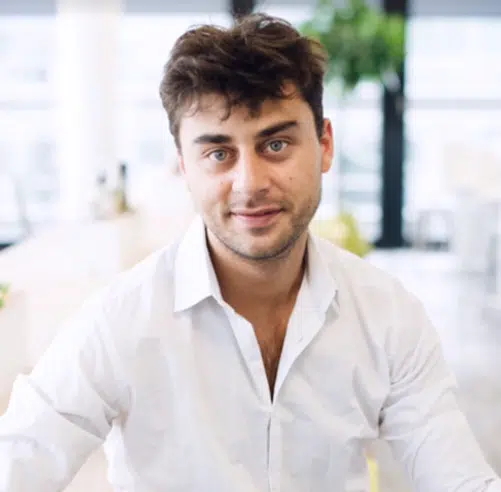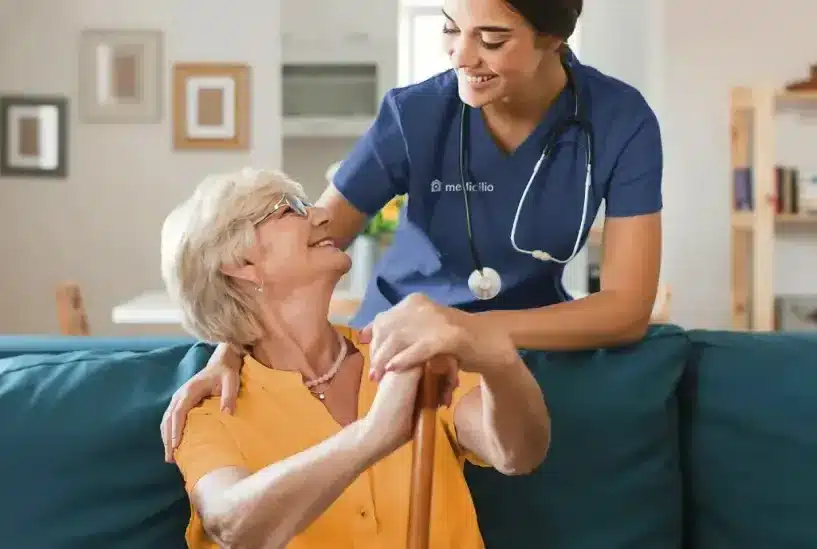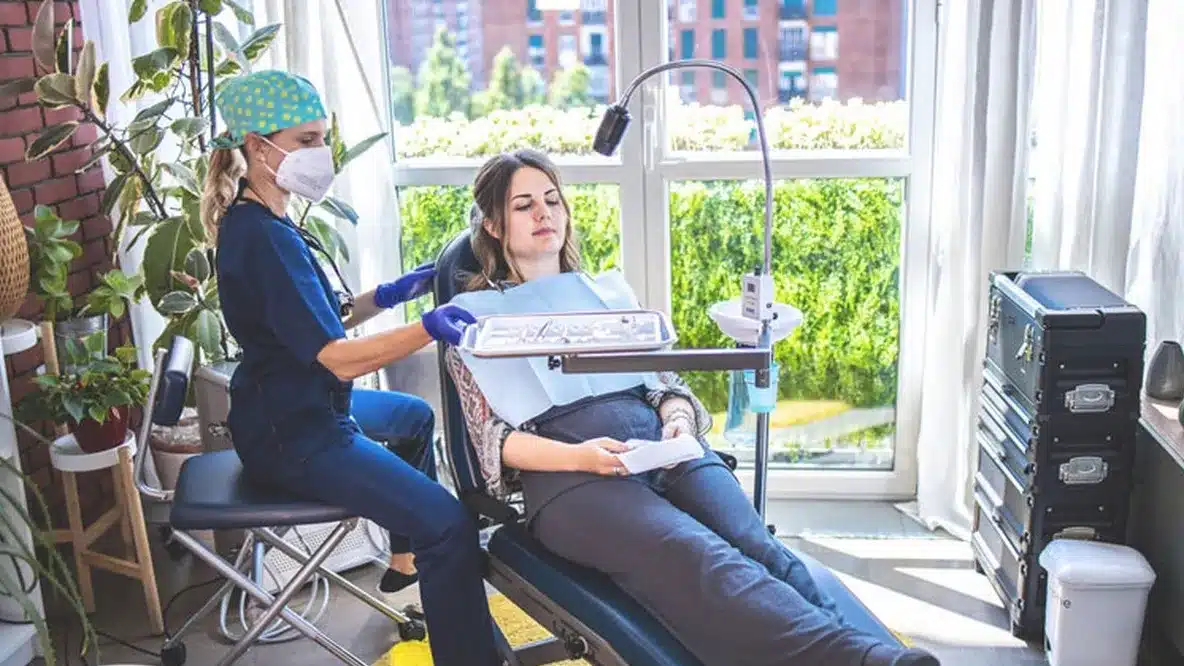
Mattia Perroni, CEO Medicilio
An economics graduate from Bocconi University, but always passionate about software and innovation, Mattia Perroni started his career as a private equity consultant, mainly in the pharmaceutical sector, working in London and Milan. After five years at Rocket Internet, he became Country Manager for Italy and International E-Commerce Director at Houzz, a Sequoia Capital portfolio company based in Palo Alto, Silicon Valley. In 2020, he realised the idea for Medicilio: a project that brings together clinical and digital talent with the aim of bringing medical examinations as close and fast as possible to patients.
How did this project come about?
“I would say it was the combination of two important factors,” Mattia explains. “Firstly, at a certain point in my life and professional career, I felt a strong desire to dedicate myself to something that would have a more tangible social impact. So I put my experience in technology and digitalisation at the service of this cause. Secondly, I was contacted by a radiology technician and during the conversation he made me think about the significant number of frail, disabled or temporarily weak people who go to hospital without a real need, causing discomfort to themselves, their carers and the hospital facilities. This situation led me to reflect on the inadequacy of current facilities and the healthcare logistics system, which often requires ambulances to transport these people. Although the project has taken different forms from the initial ones, it has evolved considerably over time from these two basic assumptions. Personally, after graduating from Bocconi, I regretted not following my true passion in the field of computer science and software. I followed a “traditional” path, so to speak, and started a career in private equity consulting, working with pharmaceutical and biotech companies in London. Later, I had the opportunity to work at Rocket Internet, becoming the first employee to manage operations in the Philippines and later in Egypt. These experiences allowed me to gain a global perspective on the world of business and technology and opened my eyes to innovative practices and approaches used by top professionals in the field. For example, I had the opportunity to visit the offices of LinkedIn, where I realised the importance of direct sales over the phone, an approach that is often lacking in Italy. These experiences made me rethink the Italian approach to work and technology, opening up new perspectives and inspiring me to adopt a more ambitious and result-oriented methodology”.
And you decided to change your life?
“Definitely yes,” Mattia confirms, “I decided one day to quit my job and return to Italy. Although there was an opportunity to move to Silicon Valley, I decided not to take it, as I had already travelled enough and wanted to settle down here. And so Medicilio was born, with a specific goal: to make medicine as accessible as possible to patients.”
How?
“Medicilio’s services are particularly important for the elderly and frail, as they reduce the need for hospital visits, thereby improving their quality of life. By reducing the number of hospital visits, we also prevent relapses and avoid costly hospital stays. We also provide comfort to carers, often women, who can spend less time and effort caring for their loved ones. Initially, we faced many challenges on our own as the hospital sector was used to the status quo. However, we are now working with institutions such as Humanitas and San Raffaele, integrating our systems to ensure a more efficient flow of data and better management of the patient, who continues to be monitored after returning home. This is leading us towards a decentralisation of the hospital system, improving care and accessibility for all.”
How does your service work?
“It’s very simple: let’s imagine – Mattia explains – a patient who needs a diagnostic test. He or she can do it in exactly the same way as the day before, ordering a pizza on Glovo and deciding to book an X-ray, an ultrasound or a blood test on Medicilio. Of course, there are some differences in the details. For example, you need a doctor’s prescription for an X-ray, which is an examination that uses ionising radiation. But in the end it is the same as ordering a pizza. This is true for patients who come to us directly, but the process is slightly different for patients who are referred to us by the hospital. Suppose a patient is under the care of a hospital like San Raffaele. In some cases, such as patients on the Humanitas Tao protocol who need regular blood coagulation monitoring, instead of going to the hospital, we go to them on behalf of the hospital. What matters to the patient is the convenience of booking a diagnostic test at home and receiving the digital results clearly and immediately.”
What tests or services can the client book?
“Our initial range of examinations included tests such as X-rays, blood tests and ultrasound, as well as dermatoscopy to detect melanoma. These were joined by cardiac diagnostics, with tests such as electrocardiograms and blood pressure monitoring. These are services that are commonly referred to as first-level diagnostics. Later, we introduced digital services such as telemonitoring, which allows patients to stay connected to the hospital through vital signs monitored by doctors, and teleconsultation, when a diagnostic test requires more in-depth discussion. For example, if an ECG suggests atrial fibrillation, the patient can consult with a cardiologist, or if a chest X-ray shows possible pneumonia, the radiologist can discuss this with the attending physician via tele-consultation. These are examples of shared clinical pathways.”
How did you get the machinery you use and how do you transport it?
“We started from scratch,” continues Mattia. “We bought an X-ray machine and hired a technician. First we had to understand everything, from hardware-software integration to data management. We couldn’t have the technician take the images at the patient’s home and then physically take the results to the doctor. We had to integrate the data so that it went directly to the doctors. I mentioned the case of radiography because it is more complex; the other tests are simpler. Even the patient master data also needs to be synchronised with the machines. Then we started working with partners all over Italy who were already doing home visits. After all, medicine started in this way, with doctors examining people at home. Some providers were already doing private examinations, such as a technician in Taranto who had equipped himself: we started to let him do examinations through our platform, acting as an intermediary between patients, providers and hospitals. As for transport, it is not as difficult as you might think. We have an aluminium tripod with an arm that connects to the X-ray tube, allowing the patient to stay in bed or sit, depending on their needs. After imaging, the patient receives the report on the platform within three hours.”
What is the difference in terms of price compared to a normal hospital service?
“It depends, of course, on the type of examination,” Mattia explains. “First of all, it is important to point out that, unfortunately, these examinations are not reimbursed by the health system, so we are talking about private health care, which is always mediated by insurance companies. My dream is that one day it will become public healthcare, but at the moment there is no DRG, so there is no reimbursement code for this type of examination, although some regions are experimenting with it, so I really think it is going in that direction. Staying with the current situation, talking about private to private, ultrasound costs about 20% more than the cost in the area. X-rays cost 50% more. To date, more than 13,000 patients have used our service and many of them consider us to be their clinic of choice. When they need an examination, they come to us as a last resort before accessing a hospital service.”
What are the next steps?
“Well, I would humbly say that we have finally realised that what we are doing works and is necessary,” says Mattia. “Now the goal is to make it available in more and more Italian cities. Currently, all our services, from X-rays to ultrasounds and more, are available in Milan, Monza, Brianza and Varese, covering the entire province of Milan and parts of the Lombardy region. They are also partially available in Turin, Rome, Pescara, Taranto and parts of Emilia-Romagna. Step by step, we are expanding our presence city by city.”





